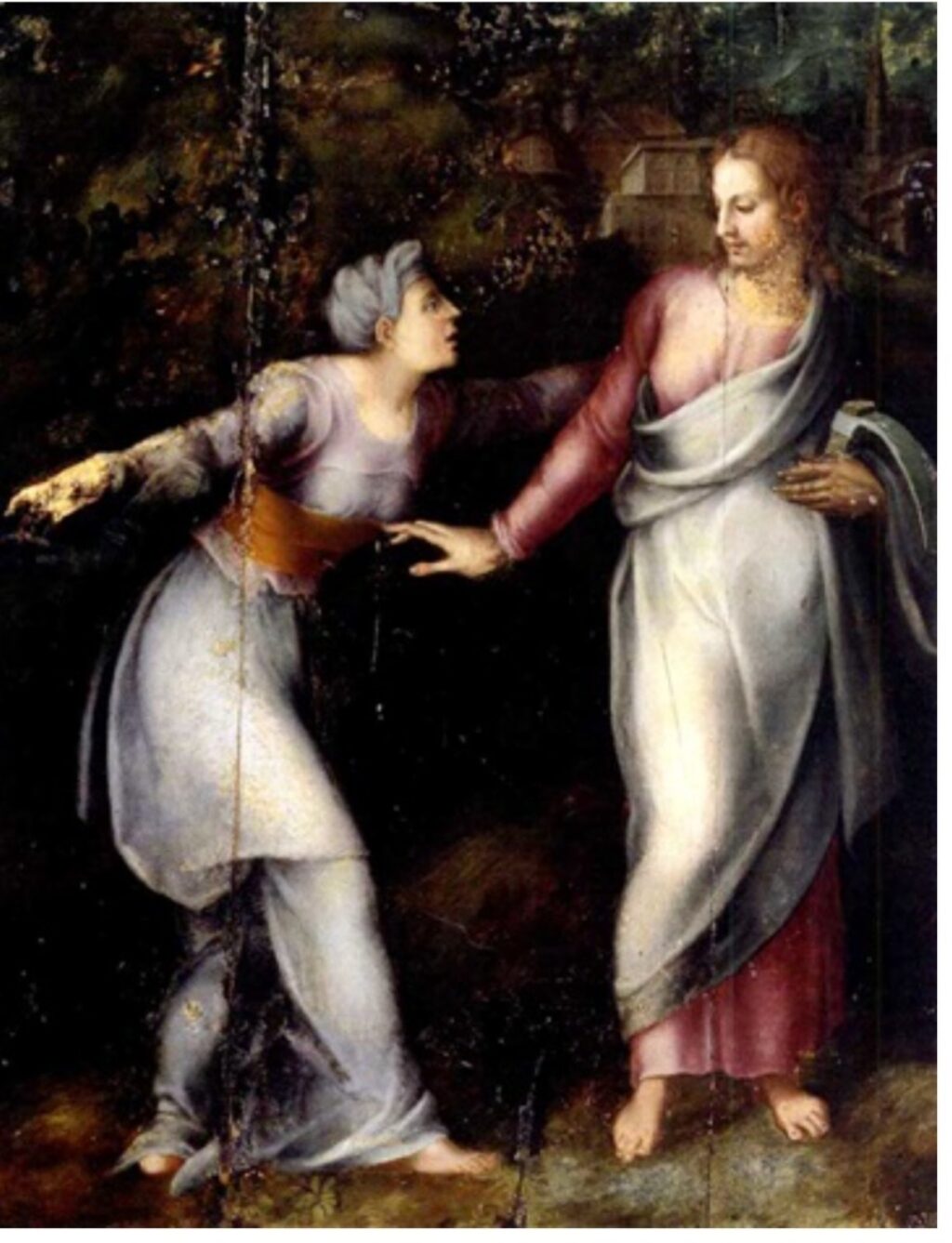Mary Magdalene, Easter and ‘Noli me Tangere’

Noli Me Tangere painting (1531) by Michelangelo
Easter is closely related to Jose Rizal’s novel “Noli Me Tangere since it is lifted from a biblical line on resurrection in the New Testament gospel of St. John (20:17).
In English, it is usually translated as “Touch me not” as Jesus’ response to Mary Magdalene right after he confronts her just outside his tomb after his resurrection. Mary Magdalene is the first person to whom Jesus shows himself alive after his resurrection.
Having discovered that his body had disappeared from the tomb, and thinking it had been removed, Magdalene met a man she believed to be a gardener and begged him to tell her where he had put Christ’s body. Jesus addressed her by name, whereupon she recognized him and reached out to touch him. But he told her not to touch him, as he had not yet ascended to heaven.
The latin phrase is “Dicit ei Iesus noli me tangere nondum enim ascendi ad Patrem meum”, which is translated “Jesus said: ‘Do not hold on to me, for I have not yet returned to my Father’.”
The complete English translation of the verse is “Do not cling to me, for I have not yet ascended to the Father; but go to my brothers and say to them, ‘I am ascending to my Father and your Father, to my God and your God.’”
This is sometimes interpreted as faith in Jesus should not be based on physical evidence, but on spiritual insight. Mary Magdalene had to trust in Jesus by faith, not by touch. The link between human beings and his person must no longer be physical.
The moment in which they were spoken, where Mary Magdalene is shown kneeling and reaching out her hands to Christ, who gently leans away from her, was a popular subject for paintings in cycles of the life of Christ, such as works of Michelangelo (1531-32), Giotto di Bondone (1304-06) in Padua, Italy, Duccio di Buoninsegna (1308-11) in Siena, Italy, Fra Angelico (1440-1442) in Florence, Italy, Hans Memling (1480) in Munich, Germany, Sandro Botticelli (1484-91) in Florence, Italy, Albrecht Dürer (1511), Titian (1514) , Hans Holbein (1526-28) in England, Nicholas Poussin (1657) in Prado, Spain, and Claude Lorrain (1681) in Germany.
The 1525 masterpiece by Antonio da Correggio in the Museo del Prado is said to be the iconographic source of the 1903 oil painting La Vie by Pablo Picasso.
In Christian belief, the resurrection demonstrates Jesus’ victory over death and his glorified state in his transition from mortality to immortality, symbolizing the transcendent power and possibility of overcoming any adversity.
The scene is also often part of the Senakulo during Holy Week as the commemoration of the suffering, crucifixion and resurrection of Jesus Christ. In medicine, the words were occasionally used to describe a disease known to medieval physicians as a “hidden cancer” or cancer absconditus; the more the swellings associated with these cancers were handled, the worse they became.
Rizal writes that ophthalmologists use this phrase in reference to a cancer of the eyelids. It symbolized the people’s blindness to the ruling government, which Rizal deemed a social cancer that people were too afraid to touch.
“Noli Me Tangere” was published in 1887 and written in Spanish which is a sweeping and passionate unmasking of the brutality and corruption of Spanish rule in the Philippines (1565–1898) that are seen as a disease of the society, thus the title, Latin for “touch me not.”
A passionate love story set against the ugly political backdrop of repression, torture, and murder.
The novel’s metaphorical landscape is filled with similarities and contrasts for two women: Maria Clara represents an image of chaste Filipina womanhood, while Magdalene is presented as a reformed sinner. Both women are rich and beautiful with long flowing hair.
Mary Magdalene is the saint who left behind her troubled former life to become the first witness to Christ’s Easter rebirth, while Maria Clara is a model for the nation’s potential for reform.
Different roles are assigned to Mary Magdalene in the four gospels: disciple, witness, caretaker and a woman cured from evil spirits. Mary Magdalene was a prominent woman, a benefactor of Jesus’ ministry, and a faithful and brave disciple that stayed with Jesus through his painful passion,
Maria Clara’s submissiveness is her tragedy as she underwent internal struggles and conflicts, particularly in relation to her love for Ibarra and her loyalty to her family.
The cover of Noli Me Tangere contains the whip and the scourge which became the emblems of the Passion of both Christ and Mary Magdalene.
These are reminders that Filipinas has to endure trials and sacrifices just like Maria Clara who would witness her entire idyllic existence torn apart by the persecution of her fiancé.
Only through such an ordeal could the people of Filipinas see with new eyes, finally become aware of the savage realities of their world, act and make changes as effectively as a re-awakened Maria Clara.
(Peyups is the moniker of the University of the Philippines. Atty. Dennis R. Gorecho heads the Seafarers’ Division of the Sapalo Velez Bundang Bulilan Law Offices. For comments, e-mail info@sapalovelez.com, or call 09175025808 or 09088665786.)
ALSO READ
Whips for flogging as symbols of sufferings
History of Christianity in the Philippines through the ‘Magellan’ song of Boholano Yoyoy Villame
Disclaimer: The comments uploaded on this site do not necessarily represent or reflect the views of management and owner of Cebudailynews. We reserve the right to exclude comments that we deem to be inconsistent with our editorial standards.
